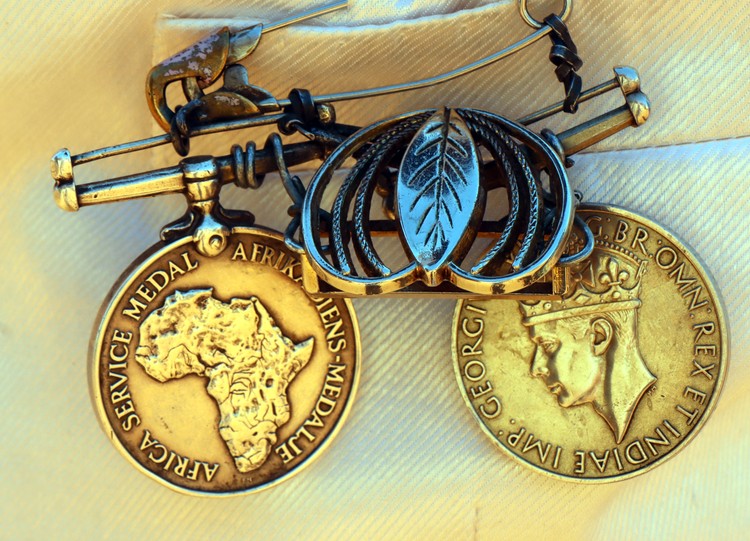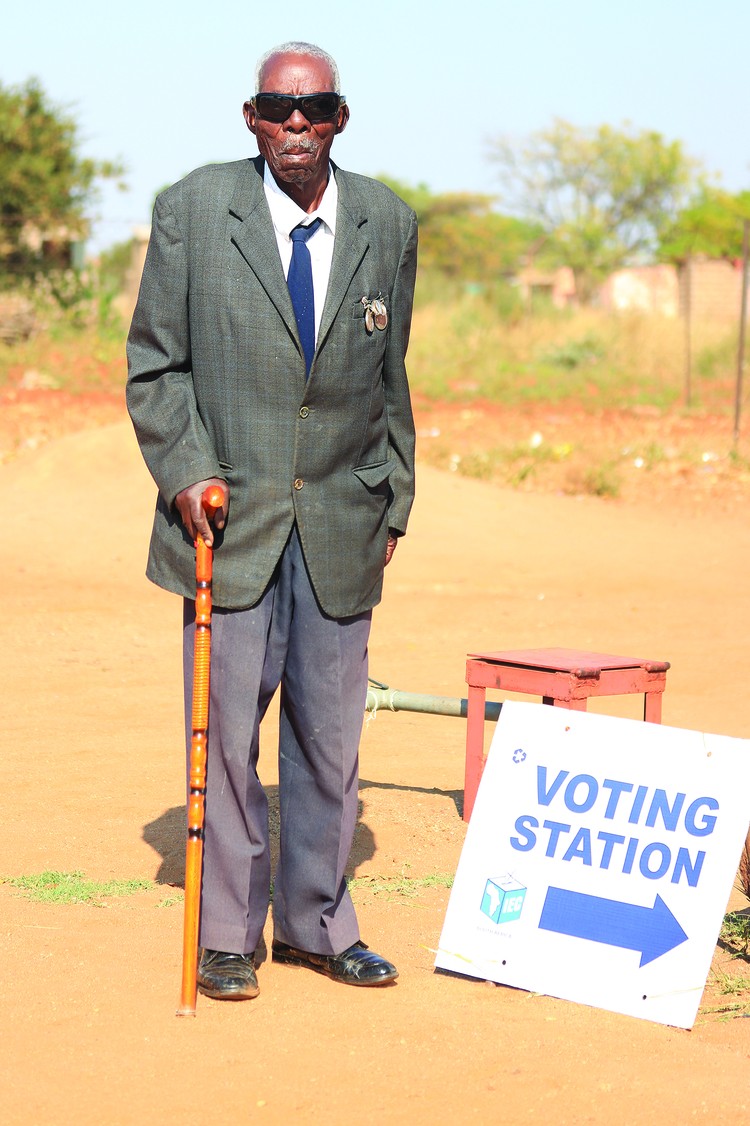At 104 years old, war veteran William Sadiki’s one wish is to have a toilet inside his house
“War is not good, and it is painful. If I were asked to go to war again, I would not agree.”
World War II veteran William Sadiki in front of his house at Ha-Manavhela. Photo: Anton van Zyl
At the age of 104, William Masindi Sadiki still has many stories to tell. Some of these are about his experiences during World War II when he was part of the North Africa campaign. He is one of the few black soldiers from that era still alive, and he proudly pins his war medals on his chest on formal occasions.
There has never been much recognition for the role that members of the South African Native Military Corps (NMC) played during this war. In Sadiki’s case, that doesn’t seem to bother him much. He lives in a small house at Ha-Manavhela, some 35 kilometres west of Louis Trichardt in northern Limpopo, and he is quite content.
Two of his daughters live next door and take care of him. His eyesight is not good, and he wears dark glasses to protect his eyes from the sun, but he is still able to move around, with a walking stick.
His only need, he says, is to have a toilet inside his house. The pit toilet he uses is situated on the furthest side of the erf, which means he must walk about 30 metres when nature calls. For a man of his age, simply walking has become a challenge, and the distance to his outdoor toilet is a journey too far.
During a visit to his home two weeks ago, we asked him about the war and how it came about that he, along with dozens of other young men from the Kutama area, embarked on a journey to the north of the African continent to fight against the German and Italian armies.
While we cannot definitively verify Sadiki’s age, the fact that he fought in World War II in the early 1940s means it is plausible that he is a centenarian.
A need for strong young men
Sadiki, affectionately known as Mushavhi in his village, recalled his recruitment vividly. “I was watching the Domba [traditional dance] in one of the royal houses when four military men, two black and two white, approached. They had asked Chief Kutama for young, strong men from our village,” he said.
There wasn’t much time for goodbyes, and the next morning the men had to report at the nearby train station, ready for the trip to Durban harbour.
The village where Sadiki was born in 1920 falls under the leadership of Vhamusanda [chief] Kutama. He remembers that roughly 100 young men from the various villages in Kutama were recruited. “One of the recruits was the son of Chief Kutama, named Johannes Tshiungulela Kutama, who was next in line for the throne,” he said. Most families had to send at least one child to the military, but because the chief had many children, he sent more than one.
William Sadiki’s medals. Photo: Anton van Zyl
Not all the recruits returned after the war ended. One of the casualties was the chief’s son, commonly known as Thina Kutama. “He died when the enemy bombed the trenches,” said Sadiki.
Chief Kutama died in 1944 before the war ended. “We had to return without Thina,” Sadiki recalled. He added that there was some sadness when they attended the inauguration of Johannes Kutama in 1945. Johannes, next in line to take the reins, ruled from 1945 until 1959, when he died.
Going to war armed with knobkierries
Sadiki remembered that it was quite a journey for the young men from what is now known as Limpopo. On their way to Durban harbour, they stayed over at different military camps, among them at Springs, where he received training. “I became a corporal, and my job was to train the new recruits in gun handling, convoying, and physical exercise,” he said. The journey by ship to Egypt took about a month.
Corporal William Sadiki became one of the roughly 80,000 black and coloured soldiers of the Native Military Corps. This is a unit whose role in shaping the outcome of the war has been underplayed by historians for decades. It is only of late that there has been renewed interest in the stories of the black and coloured soldiers. Because of the race policies of the time, they were not officially allowed to carry arms, and they were sent to the battlefields with “knobkierries and spears”.
But at the front many fought side by side with their white counterparts, with the soldiers sharing rations and even arms when it was called for. The NMC’s primary role was to offer support to the combat forces, and they did duty as labourers, drivers, and even medical staff.
“We carried weapons like .303 rifles, machine guns, and cannons,” said Sadiki. He recalled that conditions were tough, and they often had to go without a proper meal for days. “We ate small biscuits. Only two were enough to last you the whole day. Sometimes we ate porridge, and we suspected that they had put something in the food to kill the fear inside us. We did not fear anything; guns would roar, and we marched on,” he said. He added that he was so focused on war that he did not have time to miss home.
Changing the course of the war
Sadiki was recruited in 1941, and his unit’s first stop was Cairo in Egypt. The NMC’s role was to assist the Allied forces in North Africa and stop the advances of the “Desert Fox” (German Field Marshal Edwin Rommel), who was leading the Axis forces (Germany and Italy). When Tobruk, a key port city in eastern Libya, fell, the fighting intensified to stop Rommel from annexing the Suez Canal.
Even though Sadiki struggled to remember specific places and dates, the Battle of El Alamein stands out in his memory. The NMC was involved in the first and second battles at El Alamein, which took place on the Egyptian border. In July 1942, the Allied Forces retreated but stood firm at El Alamein. During the second battle, which lasted from October to November 1942, the Allied forces started to gain the upper hand and forced Rommel to retreat. This battle marked a turning point in the North African campaign.
From there, the action shifted, and Sadiki recalls that they fought in Libya, going all the way to Tunisia. From there, they were deployed in Italy and made their way through parts of Europe. When the war ended on 2 September 1945, they were on their way to Japan.
“We were then sent to a place called Swiss, where we stayed for a week before boarding a ship back home,” he said.
“War is not good”
“War is not good, and it is painful. If I were asked to go to war again, I would not agree,” Sadiki said.
It took many years for him to recover from the impact the war had on him. When he returned home early in 1946, he worked as a policeman, but he resigned after being threatened with death. He then worked at the public works department, but also resigned. Sadiki said that he later joined the railways but was fired for some misdemeanour. He was reappointed at the railways a while later and worked as a recruiter until his retirement.
Sadiki had nine children, but five of them have already died. When the interview was conducted, he had two wives, but one of them died the following week.
In his twilight years, he has found peace in the dusty village of Ha-Manavhela, where he has stayed for most of his life. He doesn’t expect to be treated like someone special, but it would help if he could get support to build a toilet. The only support he receives from the government is the SASSA grant, and that is not enough to cover such building expenses.
Earlier this year William Sadiki cast his vote during the general elections. Photo: Thembi Siaga.
Support independent journalism
Donate using Payfast

Don't miss out on the latest news
We respect your privacy, and promise we won't spam you.
Next: Fraud probe at Durban old age home
Previous: Police officer filmed assaulting man is still on duty
© 2024 GroundUp. This article is licensed under a Creative Commons Attribution-NoDerivatives 4.0 International License.
You may republish this article, so long as you credit the authors and GroundUp, and do not change the text. Please include a link back to the original article.
We put an invisible pixel in the article so that we can count traffic to republishers. All analytics tools are solely on our servers. We do not give our logs to any third party. Logs are deleted after two weeks. We do not use any IP address identifying information except to count regional traffic. We are solely interested in counting hits, not tracking users. If you republish, please do not delete the invisible pixel.



